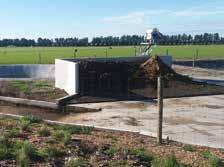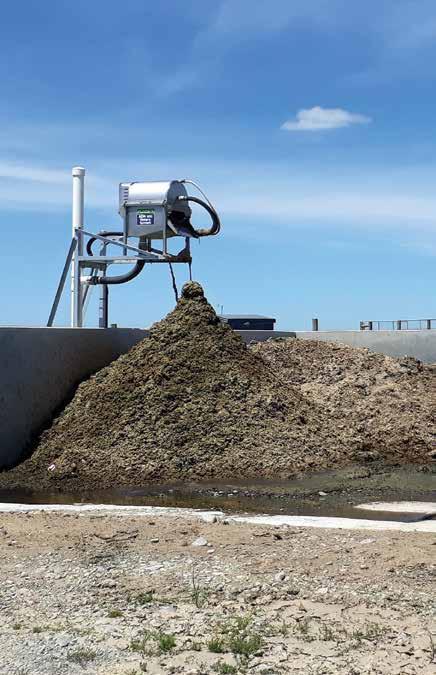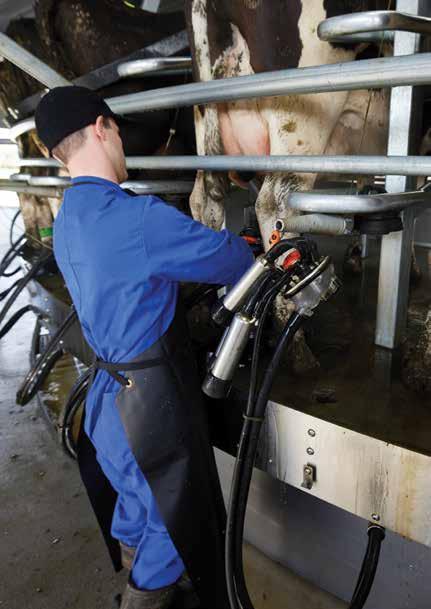
10 minute read
Environment plan drives changes
Environment plans driving change
A SURVEY of farmers in Aparima, Southland, shows farms achieve better environmental results when they have Farm Environment Plans.
Six hundred dairy, sheep and beef farmers work together in the Aparima Community Environment Project, which aims to improve the health of freshwater and reduce environmental footprint.
A recent survey of 151 Aparima farmers showed 80% have Farm Environment Plans – an increase of 23% on last year. The survey also highlighted that farmers with environment plans are more likely to implement a range of good farming practices.
“These survey results show how serious farmers are about taking care of the environment,” said Otautau dairy farmer
ABOUT THE PROJECT
THIS LARGE-SCALE project began in 2018 and involves 600 farmers in the Aparima, Pourakino, Waimatuku and coastal Longwood catchments, who are addressing water quality issues and reducing environmental footprint.
Of the 600 farmers – 216 are dairy farmers, 384 are sheep and beef farmers.
Edwin Mabonga, from mid-Aparima.
Of the farmers surveyed, 95% have excluded stock from waterways – up 4% on last year. About 87% use nitrogen fertiliser strategically – up 4% (this means using fertiliser only as needed to maximise pasture uptake and only on certain parts of the farm).
“Farm Environment Plans identify environmental risks and management options on the farm, and contribute to improving water quality and other environmental benefits,” said Mabonga.
“They are living, breathing documents that help farmers achieve better environmental outcomes.”
Plans must include actions to reduce farm sediment and nutrient loss, outline how wintering rules will be implemented, and where to riparian plant and fence. The plans are reviewed annually.
Thousands of farms already have a comprehensive Farm Environ-
Otautau farmer Edwin Mabonga says the survey results show how serious farmers are about taking care of the environment.
ment Plan and sector groups are continuing to further develop them as an effective way to accel-
WHY IS THE MARKET LEADER
SPREAD EAGLE LEG SPREADER
MAKES CUPPING-ON EASIER AND WILL ENSURE A CLEANER, FASTER, AND MORE EFFICIENT MILKING Onfarm Solutions believe that dairy farm innovation must make life simpler, no exceptions. E ective teat spraying will help you win the war against Mastitis.
EASY TO INSTALL AND INEXPENSIVE TO MAINTAIN
RELIABLE AND MANAGE PRECISE SPRAY SCC
PATTERN OVER
SPEEDS 800 SYSTEMS
DOWN TO INSTALLED 5.5 SECONDS ACROSS THE
PER BAIL GLOBE
AFFORDABLE COMPATIBLE AUTOMATION
WITH ANY
MILKING
SYSTEM
NOW READ IT ONLINE
READING THE PAPER ONLINE HAS NEVER BEEN EASIER
❱❱ BREAKING NEWS ❱❱ MACHINERY
REVIEWS ❱❱ ANIMAL HEALTH ❱❱ MANAGEMENT
STORIES ❱❱ COMPETITIONS ❱❱ AND MUCH
MORE...

erate further improvements.
Farmers in the Aparima Community Environment Project are making significant changes which illustrate the type of innovation and commitment needed to surpass good management practices and set farmers in good stead for future.
Mabonga said his Farm Environment Plan ensures all his team know and understand the way the environment is looked after on the farm. “For us a big benefit is to have everyone on the farm thinking environmentally.”
Mabonga and his wife Fungai are equity partners and have been carrying out farm riparian planting for 10 years. All staff are involved in tree planting, which gives them a sense of ownership in the environmental work, he said.
The Aparima Community Environment Project is led by farmers and supported by DairyNZ, Beef + Lamb New Zealand, Environment Southland and Fonterra.



Meander ATM Apple-ET S1F Dam of Meander MH Armour-ET S2F Discovery Project Bulls.

Cows with lower carbon footprint, higher milk yield
A BREEDING programme, delivering cows that milk better and are better for the environment, is progressing well.
The Discovery Project, a joint initiative between Holstein Friesian New Zealand (HFNZ) and LIC has delivered a total of 61 sires into LIC’s sire proving programme since 2013. Five of these sires have then gone on to graduate into LIC’s Premier Sires teams and been marketed.
Running since 2013, the project uses genomic testing to screen and select 300 of New Zealand’s best Holstein Friesian heifers every year.
Up to 50 heifers are then chosen to go on and provide eggs that are crossed with specially selected bulls.
Any resulting bull calves are then genetically screened for desired traits including the animal’s overall type, milk production potential and the animal’s potential for lowering environmental impacts including greenhouse gas emissions.
The aim is to continually improve the genetics of the national Holstein Friesian herd to produce cows that milk better and are better for the environment.
South Canterbury farmers Tony and Keri O’Connor, Tronnoco Farming Co Ltd, were founding participants in the initiative.
They bred Tronnoco MH SambaET S2F who has been selected into the LIC Premier Sires Forward Pack team this year, but Tony says the bull would never have existed if not for the programme, because the bull’s dam died as a two-year-old.
“Losing an animal is never something you want to happen but because of the programme we had the embryo and as a result we have Samba. That is also why there are not a lot of records for his dam,” says Tony.
Samba’s grand dam is creating her own legacy in his herd, however, having produced over 900kgMS three times and still milking in the herd at 10-years-old.
She has also produced two daughters that have also produced over 900kgMS, says Tony.
Without the programme those genetics would have been lost to the national herd.
The latest bull update places Samba as the third highest Holstein Friesian bull for protein BV.
Tony says the Discovery Project has proven itself to be the best way to use modern technologies to genomically test animals and generate animals with the traits the dairy industry needs as quickly as possible.
The other Holstein Friesian bull to make an LIC team was Meander MH Armour-ET S2F, who is named in LIC’s, Premier Sires Daughter Proven team.
Breeders Robert and Anne Marie Bruin, Otautau, Meander Holsteins, says they have been involved with the Discovery Project from the start because breeding top bulls also means they are breeding top cows and continually improving the genetics of their herd.
“They say success is 30 per cent genetics. If you can get the genetics right, you can make huge leaps forward.”
LIC livestock selection manager Simon Worth says he is really pleased with the quality of the 17 code bulls coming through (bulls that produced their first semen straws in 2017) and although it was early days with only one round of herd testing and TOP classification from their daughters, he says the two Holstein Friesian bulls were part of a group that were looking really good.
Rethink your routine

Milk your cows quicker, with less staff, thanks to the new iCR+ Intelligent Cluster Remover.
Taking away the need to push a button to activate cluster vacuum and the requirement to manually remove cups makes for an efficient, consistent milking experience. Plus, post-teat spraying can be taken care of, too.
In fact, one operator can milk more cows in less time thanks to the new iCR+ Intelligent Cluster Removers!
Time to rethink your milking routine?
Call 0800 GEA FARM, or your local dealer for a quote. gea.com/new-zealand
Driving dairy efficiencies? We can help.
Myth-busting with Jersey herd
ROSS AND Kristy Conder are not milking your typical Southland herd. The successful farming couple 50:50 sharemilk 840 predominantly Jersey cows at Otapiri, near Winton. The sight of a largely Jersey herd is less common in the area and the couple say that they are busting the myth that a bigger, blacker cow is needed to be profitable in the south. Originally from Auckland, Ross got into farming following a chance encounter with an enthusiastic Primary ITO tutor who encouraged him to consider dairying as a career. Kristy grew up on a farm and the two did a role reversal for a short period while Kristy studied in Auckland and Ross worked his way up the farming ladder in Ngatea. In 2016 the couple moved south to begin their sharemilking career for Dairy Farms NZ Limited. Five seasons on and they run a relatively low input system on the 274 hectare (235 effective) mixed contour farm, feeding approximately 400kg of palm kernel and grain


through in-shed feeding. The herd produces around 380kgMS/ cow and around 1380kgMS/ ha.
Around 20-30% of the herd is milked once-aday (OAD) in spring and summer with the full herd on OAD from April/May onwards. “We trade off a small amount of production with our milking regime but we make up for that in cow health, condition and fertility,” says Ross. The herd is significantly above the industry average for reproductive performance, averaging between 75-82% over the last five seasons. The herd also averages a 7% empty rate from 12 weeks of mating, but it has been as low as 5%. Even more impressive is the fact that no intervention is used to achieve these results. “That’s one of the main advantages of Jerseys – they are highly fertile,” says Ross. “We have found that by focusing on cow condition and using OAD as a tool to manage lighter cows or noncyclers, we don’t need any hormonal intervention to achieve strong reproduc-
There is a strong demand and limited supply of Jersey bull calves.

tive performance.”
The couple use 100% Jersey bulls for AB and say that they are selecting their genetics with a bigger framed Jersey in mind. They say, over time they have built up a herd of superior type to the typical Southland cow. “It’s a combination that gives us the positive traits of a Jersey animal – such as higher milksolids percentage, superior fertility, easy calving, good feet, and mobility – with a little bit of extra size.” Equity growth has been a big focus for their business and stock sales have helped to drive this.
“We have a real niche in Southland when it comes to Jersey bull calves. There is a strong demand and limited supply in our area so we have been able to capitalise on that,” says Kristy. The couple also has an abundance of surplus mixed-age stock to sell annually. Rearing 25% young stock, they aim to bring through around 21-22% as in-calf heifers. This, coupled with their lower empty rate, means that there is surplus stock each season. “Our stock sales have been an important factor in our business growth and it has allowed us
Sharemilkers Ross and Kristy Conder.
to get to our herd goals quicker by selling off the higher Friesian-content animals,” says Kristy. The couple have a strong focus on cost control and say that for them it is about getting the basics right, while keeping things simple so that they can grow. It’s a goal that has seen them purchase a 480-cow farm in equity partnership this year. The couple will contract milk the farm and play a management role across both properties.
The couples longer term vision is to purchase more land and move into full ownership.
Leading the way in Effluent Monitoring
MONITORING SOLUTIONS INCLUDING: ➤
Effluent monitoring, fail safe systems and solutions Valve control Greenwash, transfer control Kline monitoring Travelling irrigator monitoring Centre pivot monitoring Tank level and flow monitoring Milk vat monitoring Weather stations Electric fence monitoring Flow meter monitoring
Soil Moisture Sump Monitoring Text alerts Computer graphing software Phone app Auto drafting controller


